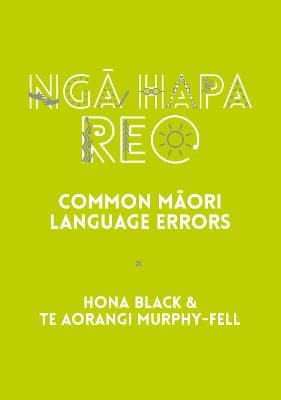Ngā Hapa Reo nā Hona Black rāua ko Te Aorangi Murphy-Fell
Reviewed by Nā Hēmi Kelly i arotake
E te hunga e pīkoko ana ki tō tātou reo, he pukapuka hou tā tātou kua whakaputahia i tēnei wiki, i Te Wiki o te Reo Māori. Ko tōna ingoa, ko Ngā Hapa Reo. Ko ōna kaituhi, ko Hona Black rāua ko Te Aorangi Murphy-Fell. Ko te tuatoru tēnei o ngā pukapuka nā Hona e aro ana ki ngā āhuatanga o te reo. Ko te tuatahi tēnei nā Te Aorangi.
E kī ana ngā mātanga, ko tā te reo he whakaata i te ahurea o te iwi. I roto i ngā tau kua kaha te whakaekea o te reo Māori e te reo Pākehā, me ōna whakaaro i ahu mai i tōna anō ahurea. Ā, koinei te pūtake o ētehi o ngā hapa e rārangi mai ana i te pukapuka nei. Ka kīia ēnei e ngā kaituhi, he hapa ā-whakaaro. Kia tiki noa au i tētehi tauira, “He aha tēnei mō?” Ā, e whai ana te rerenga nei i te whakatakotoranga o ngā kupu i te reo Pākehā, “What’s this for?”
Ka rere ngā whakamahuki a te tokorua nei mō te take i hapa ai te rerenga nei i te reo Māori, kātahi ka homai te rerenga tika, arā, “Hei aha tēnei?” Ka takoto anō i a rāua ētahi atu tauira hei ārahi i te hunga ako. Ko te pai, kei ngā reo e rua ngā kōrero katoa. Nō reira, mā ngā reanga matatau ki te reo katoa te pukapuka nei.
Kua wāwāhia ngā kai o te pukapuka ki ōna rourou e ono, arā, ko ngā hapa ā-kupu, ko ngā hapa wetereo, ko ngā hapa ā-whakaaro, ko ngā hapa pūmuri, ko ngā hapa whakakāhore me ētahi anō hapa. Me mihi rā ngā kaituhi i whakapau kaha ki te kohikohi i ēnei hapa kua horapa i waenganui i te hapori kōrero Māori.
Me whakaae tātou, he āhuatanga te hapa ka pā. Kāore hoki e taea te pēwhea. He āhuatanga ka pā i te wā o te ako i te reo, ahakoa te reo. Engari kia kaua tērā e waiho hei take e wahangū ai tātou. Koirā i puta ai i a Pānia Papa āna kupu, kua rongonui nei, “Nau mai te hapa!” He akiaki tāna i te iwi kia kaha te kōrero, kia kaha te rere o te reo. Mātāmua ko tērā, kātahi ka hoki ki te whakatikatika.
Tēnā kōrua, e hoa mā, e ngā ringa tuhi. Tērā te kōrero a ngā kaiako e mea ana, “Mā te hapa ka ako.” Engari me pēwhea te tangata e ako ai ki te kore hoki e mōhio e hapa ana tōna reo. Nā, kua waiho mai e kōrua tētehi taonga e kite mai ai te tangata i te hapa me te tika. Ngā Hapa Reo, e puta ki te ao mārama hei nanao atu mā te hunga ako e whai nei kia pakari ake, kia Māori ake, kia tika ake ō rātou nā reo.
_________________________________
Ngā Hapa Reo by Hona Black and Te Aorangi Murphy-Fell
Reviewed by Hēmi Kelly
For those passionate about our language, a new book has been released this week during Te Wiki o te Reo Māori (Māori Language Week). Its title is Ngā Hapa Reo, and its authors are Hona Black and Te Aorangi Murphy-Fell. This is Hona’s third book focusing on aspects of the language and the first for Te Aorangi.
Experts say that language reflects the culture of its people. Over the years, te reo Māori has been strongly influenced by English and its associated cultural concepts. This has led to some of the mistakes outlined in this book. The authors refer to these as conceptual errors. For example, “He aha tēnei mō?” directly follows the word order of the English phrase “What’s this for?”
The authors explain why this sentence is incorrect in te reo Māori, and then offer the correct phrase: “Hei aha tēnei?” They provide further examples to guide learners. What makes this book particularly valuable is its bilingual format, with all explanations given in both te reo Māori and English, making it useful for learners at all levels of proficiency.
The book’s content is divided into six sections: vocabulary errors, grammar errors, conceptual errors, suffix errors, negation errors, and other common mistakes. The authors should be commended for their effort in gathering these common errors that are widespread within the Māori-speaking community.
We must accept that making mistakes is a natural part of the learning process—there’s no avoiding it. This happens with any language. However, mistakes should never be a reason to stop speaking. This is why Pānia Papa’s well-known phrase “Nau mai te hapa!” (“Welcome mistakes!”) is so important. She encourages people to speak with confidence and let the language flow. First and foremost, speak—then later, go back and correct any mistakes.
Thank you both, dear friends, for your work on this book. There’s a saying among language teachers: “You learn through mistakes.” But how can someone learn if they don’t even realise they are making them? You’ve provided a valuable resource that helps people identify their errors and learn the correct forms. Ngā Hapa Reo is a much-needed and practical tool for learners to strengthen their reo, to make it more authentically Māori, and to improve their overall language accuracy.
